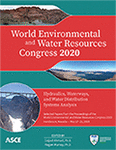World Environmental and Water Resources Congress 2020
Spread of Salt through a Looped Water Distribution System and an Alternative to Conventional System Flushing
Publication: World Environmental and Water Resources Congress 2020: Hydraulics, Waterways, and Water Distribution Systems Analysis
ABSTRACT
Saltwater intrusion in fresh water aquifers due to excessive groundwater pumping and sea-level rise has become a major concern mostly in coastal cities around the world. Subsequently, salt can be drawn to water distribution systems and can cause health problems if the amount is excessive. To document the time and location of unsafe levels of salt, system network modeling was performed here for a realistic looped water distribution system having 958 pipes, 874 junctions, one tank, and one ground water source. It was found that (1) the salt reaches the upstream portions quickly, (2) salt spread is sensitive to the conditions of outer junctions, and (3) salt level oscillates due to oscillating user demand. In addition, the optimal location of a flushing pond was examined as an alternative to conventional system flushing, where the flushing pond will capture the maximum amount of contaminated water possible. It was found that a flushing pond can reduce the amount of contaminated water discharged to the environment and the pond holding capacity is sensitive to its location.
Get full access to this article
View all available purchase options and get full access to this chapter.
REFERENCES
Ayolabi, E.A., Folorunso, A.F., Odukoya, A.M. and Adeniran, A.E., 2013. Mapping saline water intrusion into the coastal aquifer with geophysical and geochemical techniques: the University of Lagos campus case (Nigeria). SpringerPlus, 2(1), p.433.
Baird, C.S., 2013. Science Questions with Surprising Answers. http://wtamu.edu/~cbaird/sq/2013/09/23/how-does-dissolving-a-salt-molecule-in-water-make-its-atoms-ionize/
Bear, J., Cheng, A.H.D., Sorek, S., Ouazar, D. and Herrera, I. eds., 1999. Seawater intrusion in coastal aquifers: concepts, methods and practices (Vol. 14). Springer Science & Business Media.
Dam, T. H. T., Amjath-Babu, T. S., Bellingrath-Kimura, S. and Zander, P. 2019. “The impact of salinity on paddy production and possible varietal portfolio transition: a Vietnamese case study.” The International Society of Paddy and Water Environment Engineering.
Dupuis, D., Sprague, E., Docherty, K. M. and Koretsky, C. M. 2019. “The influence of road salt on seasonal mixing, redox stratification and methane concentrations in urban kettle lakes.” Science of the Total Environment
Edwards, B.D. and Evans, K.R., 2002. Saltwater intrusion in Los Angeles area coastal aquifers: the marine connection (Vol. 30, No. 2). US Department of the Interior, US Geological Survey.
El-Fadel, M., Deeb, T., Alameddine, I., Zurayk, R. and Chaaban, J., 2018. Impact of groundwater salinity on agricultural productivity with climate change implications. International Journal of Sustainable Development and Planning, 13(3), pp.445-456.
EPA, 2003. Drinking Water Advisory: Consumer Acceptability Advice and Health Effects Analysis on Sodium. U.S. Environmental Protection Agency, https://www.epa.gov/sites/production/files/2014-09/documents/support_cc1_sodium_dwreport.pdf
Faneca Sànchez, M., Bashar, K., Janssen, G., Vogels, M., Snel, J., Zhou, Y., Stuurman, R.J. and Oude Essink, G., 2015. SWIBANGLA: Managing salt water intrusion impacts in coastal groundwater systems of Bangladesh.
Gopinath, S., Srinivasamoorthy, K., Saravanan, K., Suma, C.S., Prakash, R., Senthilnathan, D., Chandrasekaran, N., Srinivas, Y. and Sarma, V.S., 2016. Modeling saline water intrusion in Nagapattinam coastal aquifers, Tamilnadu, India. Modeling Earth Systems and Environment, 2(1), p.2.
Greenfieldboyce, N., 2007. Study: 634 million people at risk from rising seas. npr.
Home Advisor, 2019. Landscape Cost Guides, https://www.homeadvisor.com/cost/landscape/
Mohammadi, M.H., Khataar, M. and Shekari, F., 2017. Effect of soil salinity on the wheat and bean root respiration rate at low matric suctions. Paddy and Water Environment, 15(3), pp.639-648.
Rossman, L., 2000. EPANET 2 User’s Manual. Environmental Protection Agency, https://nepis.epa.gov/Adobe/PDF/P1007WWU.pdf
Roy, D. K. and Datta, B., 2018. Influence of sea level rise on multiobjective management of saltwater intrusion in coastal aquifers. Journal of Hydrologic Engineering, v 23, n 8, August, 2018.
Shah, J.B., Lakin, D., Singh, S.P., Raval, S., Grimes, M., 2001. Hydrant Flushing Improves Water Quality. Water Engineering & Management, 148(6), pp.24-25.
Spatafora, J. 2008. What is salt water intrusion? Johnson State College, http://kanat.jsc.vsc.edu/student/spatafora/setup.htm.
Spechler, R.M., 2001. The relation between structure and saltwater intrusion in the Floridan Aquifer System, Northeastern Florida. US Geological Survey Karst Interest Group Proceedings, pp.25-29.
Tran Anh, D., Hoang, L., Bui, M. and Rutschmann, P., 2018. Simulating future flows and salinity intrusion using combined one-and two-dimensional hydrodynamic modelling—the case of Hau River, Vietnamese Mekong delta. Water, 10(7), p.897.
U.S. Energy Information Administration, 2019. Electricity, https://www.eia.gov/electricity/state/
USGS, 2016. Why is the Ocean Salty? U.S. Geological Survey, https://water.usgs.gov/edu/whyoceansalty.html
Walski, T., Wu, Z.Y., Hartell, W. and Culin, K., 2008. Determining the best way to model distribution flushing. In World Environmental and Water Resources Congress 2008: Ahupua'A (pp. 1-10).
Werner, A.D., Bakker, M., Post, V.E., Vandenbohede, A., Lu, C., Ataie-Ashtiani, B., Simmons, C.T. and Barry, D.A., 2013. Seawater intrusion processes, investigation and management: recent advances and future challenges. Advances in Water Resources, 51, pp.3-26.
WHO, 2003. Chloride in drinking water. World Health Organization, WHO/SDE/WSH/03.04/03, http://www.who.int/water_sanitation_health/dwq/chloride.pdf
Xiao, H., Wang, D., Medeiros, S.C., Bilskie, M.V., Hagen, S.C. and Hall, C.R., 2019. Exploration of the effects of storm surge on the extent of saltwater intrusion into the surficial aquifer in coastal east-central Florida (USA). Science of the total environment, 648, pp.1002-1017.
Information & Authors
Information
Published In
World Environmental and Water Resources Congress 2020: Hydraulics, Waterways, and Water Distribution Systems Analysis
Pages: 395 - 402
Editors: Sajjad Ahmad, Ph.D., and Regan Murray, Ph.D.
ISBN (Online): 978-0-7844-8297-1
Copyright
© 2020 American Society of Civil Engineers.
History
Published online: May 14, 2020
Published in print: May 14, 2020
Authors
Metrics & Citations
Metrics
Citations
Download citation
If you have the appropriate software installed, you can download article citation data to the citation manager of your choice. Simply select your manager software from the list below and click Download.
